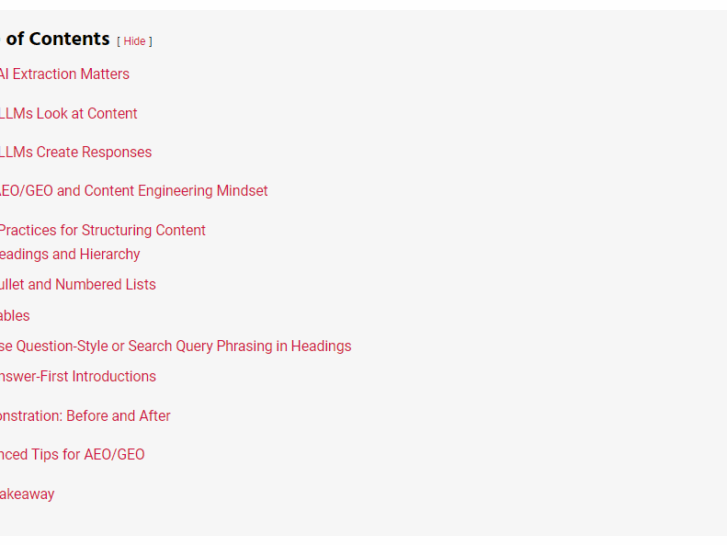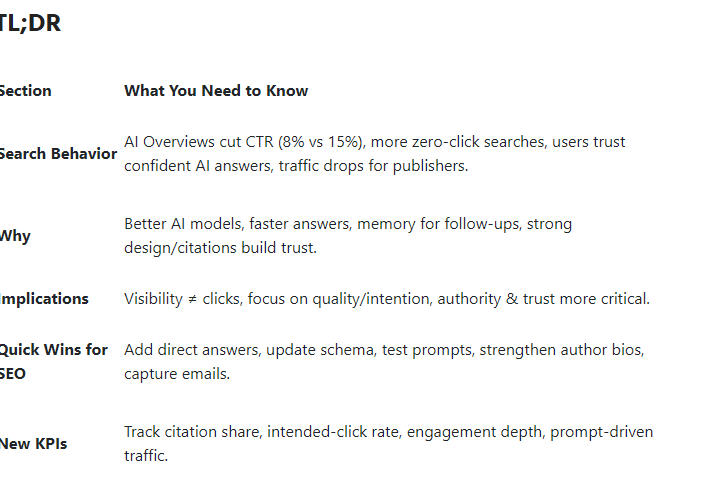Ranking on page one doesn’t cut it anymore. AI platforms and LLMs are taking over the spotlight—pushing traditional organic search results further down the page. If you want your brand to still be seen and trusted online, then your content must be structured in a way that both people and LLMs understand.
But unlike traditional search engine crawlers that depend on markup, metadata, and link structures, LLMs understand content in a completely different way. In SEO, we often focus on structured data (like Schema markups) to help search engines read our pages. While that layer of markup is still useful, structuring content for AI extraction (and AEO in general) goes far beyond adding tags.
The good news? This is something you can control. Understanding how LLMs see and digest content is key to increasing your chances of appearing in AI Overviews, Perplexity summaries, or ChatGPT citations. This guide will show you how to do just that.
Author’s Note:
This article is the fifth entry in my ongoing AI + SEO (AEO) series. If you want the full picture of how search is evolving, I recommend starting with the earlier parts—they lay the groundwork for understanding how AI is reshaping content and visibility.
Catch up on the series:
- How AI Overviews Impact CTR and SEO – How Google’s AI results are changing clicks and rankings.
- Mapping Content to User Goals – Structure content around intent to drive engagement.
- How Generative AI Is Changing Search Behavior – Why AI is transforming how people find and trust information.
- How Generative AI in Search Works – The mechanics behind how LLMs interpret and rank content.
Read the series in order to understand what’s changing, and how to create content that wins in both human and AI search.
Why AI Extraction Matters
Let’s face it, most users don’t click through as much anymore. They read summaries from Google or AI chatbots, then move on. That means if your content isn’t the one being quoted, you’re invisible.
Here’s why structuring your content for AI matters:
- More Visibility: Even if you’re not ranking #1, you can still get quoted.
- Authority Positioning: AI is presenting you as the “trusted source.” That builds your reputation fast.
- Higher CTR: People are more likely to click when they see you in the summary.
- Trust and Recall: Being mentioned in AI-generated answers makes your brand stick in people’s minds.
Think about it. Two businesses write about the same topic. One writes in big paragraphs without structure. The other uses clear answers, lists, and tables. Which one do you think the AI will choose?
How LLMs Look at Content
Large language models (LLMs) like GPT-4 and Gemini process content very differently from traditional search crawlers. Instead of scanning markup, metadata, and links, they ingest the text, break it into tokens, and analyze the relationships between words, sentences, and ideas using advanced attention mechanisms.
When evaluating content, LLMs consider factors such as:
- Information order: how ideas flow from one point to the next.
- Concept hierarchy: the use of clear headings and subheadings to show structure.
- Formatting signals: elements like bullet points, tables, and bold summaries that highlight key insights.
- Repetition and reinforcement: consistent emphasis on important points that help AI models determine what matters most.
By understanding how LLMs process and prioritize information, you can format your content in ways that make it more discoverable, quotable, and AI-friendly.
How LLMs Create Responses
When a language model builds a response, it doesn’t pull a full page. It pieces together sentences and sections it understands best. To be part of that mix, your content must be easy for AI to read and interpret.
That means writing content that is:
- Organized logically, with each section focused on one idea.
- Consistent in tone and language, so nothing feels disconnected.
- Formatted for quick scanning, using FAQs, step-by-step lists, or definition-style intros.
- Clear and straightforward, prioritizing understanding over clever phrasing.
In short, AI rewards clarity, structure, and intent. The better your content communicates ideas at a glance, the more likely it is to be quoted, shared, and remembered.
The AEO/GEO and Content Engineering Mindset
If you want to get serious about structuring content for AI, then you need to stop thinking like in terms of traditional SEO, and start thinking like a content engineer. This is where AEO, also known as GEO, comes in.
Here are the key principles:
- Semantic Chunking: Break your content into small, focused parts. Each section should answer one idea clearly. Remember, AI doesn’t read your article as one long essay. It retrieves and quotes chunks.
- Clear Sentences: Write in subject–predicate–object format. Example: “An HRIS manages payroll for employees.” This removes ambiguity and makes it easier for machines to parse.
- Entity Context: Use related terms together so AI systems understand the connections. For example, if you’re writing about SEO, mention ranking, backlinks, content, and indexing in the right context.
- Structured Data: Knowing how to add schema markups is a must. But you’ll also benefit by going beyond that. Map your own internal knowledge. Use categories and ontologies to make your content more machine-friendly.
- Unique Insights: Don’t just repeat what’s already out there. Add your own case studies, data, or experiences. AI prefers fresh information that adds value.
This isn’t about gaming the system. Structing content for AI extraction is about clarity, precision, and creating content that works for both people and machines.
Best Practices for Structuring Content
Headings and Hierarchy
Headings are not just for design. They signal to both readers and AI what the section is about.
What to do:
- Use H1, H2, and H3 tags to establish a logical content hierarchy.
- Add keywords and entities naturally in your headers.
- Keep each section focused on a single point.
Example:
- Bad: “Tips and Tricks”
- Good: “Best Practices for AI Optimized Headings”
When AI scans your content, it uses your headers as landmarks. Don’t make them vague. Make them count.
Here’s how I structured this article with H2s and H3s:
Bullet and Numbered Lists
Bullets make information scannable. They also make it easier for AI to extract key points.
What to do:
- Keep bullets short and punchy.
- Start each with a strong word: a verb, a noun, or an entity.
- Use lists for benefits, steps, or comparisons.
Example:
- Define semantic chunks clearly
- Use schema markup in FAQs
- Limit lists to 5 to 7 items
If you want your content to be quoted by AI systems, lists are one of your best tools. Just remember—bullet points only work when readers and search engines understand them. Always include a short introduction that explains what the list is about and why it matters.
Tables
Tables are gold for AI extraction because they show relationships clearly.
What to do:
- Use descriptive headers.
- Keep your data clean and simple.
- Don’t overload tables with fluff.
Example:
| Format | AI-Unfriendly | AI-Optimized |
| Paragraph | Long and mixed ideas | One idea per chunk |
| Header | Generic, ex: “Features” | Entity-rich, ex: “Best HRIS Features” |
| List | Dense text | Concise and skimmable |
The simpler your table, the more likely AI will pick it up.
Here’s an example of one I made in a previous article:
Use Question-Style or Search Query Phrasing in Headings
Headings don’t just help section content, they act like anchors that help LLMs understand how topics relate to one another. I recommend using question-style phrasing for your H2s and H3s for this reason.
When you write H2 and H3 headings in the form of search queries, you’re doing two things at once:
- Helping AI recognize intent and match your content to specific user questions.
- Making it easier for people to scan and find the exact information they came for.
Good headings mirror the exact phrases your audience types into search engines. For example:
- “How does an HRIS improve employee management?”
- “What are the benefits of automating payroll with an HRIS?”
- “Best practices for implementing an HRIS system”
Avoid vague headers like “Smarter HR Tools” or “Why It Matters.” They don’t communicate a clear question or intent, which makes it harder for both humans and AI to understand the relevance of your content.
Answer-First Introductions
Never bury the lead. AI is looking for direct answers.
Formula:
Answer first → Explanation → Example
Example:
- Good: “An HRIS is a digital system that manages payroll, employee data, and compliance. It helps HR teams streamline operations and reduce errors.”
- Bad: “In today’s business environment, HR processes are evolving…”
When you start with the answer, you’re not only helping AI. You’re helping readers too.
Demonstration: Before and After
Before (Unstructured):
“Semantic chunking is important in AI SEO. It involves splitting ideas into parts, but some writers don’t use it. This can confuse retrieval systems, and your content may not show up in results.”
After (Optimized):
What Is Semantic Chunking?
Semantic chunking is the practice of breaking content into focused sections so AI can retrieve them more accurately.
- One idea per section
- Uses clear entities like “AI” and “retrieval systems”
- The answer is in the first sentence
The second version wins because it’s clear, concise, and structured.
Advanced Tips for AEO/GEO
Once you master the basics, take it to the next level:
- Build Content Clusters: Group related articles and interlink them. This strengthens your topical authority.
- Create Entity Maps: Show how terms and ideas connect across your site. This helps AI understand context.
- Use Custom Ontologies: If your niche uses specialized terms, define them clearly and consistently.
- Be Consistent Across Channels: If you share a fact on your blog, repeat it on your socials and guest posts. AI looks for corroboration.
- Publish Original Research: Data, surveys, and unique case studies give AI something new to cite.
These are the strategies that separate generic content from AI-optimized content. If you want to appear in AI-generated summaries, then you need to format your content as something worth quoting. Answer questions directly, keep your layout clean, and make sure every section delivers standalone value.
Key Takeaway
AI is reshaping search. If you want to get quoted in AI Overviews or chat engines, you need to make you’re structuring content for AI extraction. That means clear headings, answer-first intros, bullet lists, and tables. It also means breaking down your content into chunks, adding unique insights, and thinking like a content engineer.
Remember this, you’re not just writing for people anymore. You’re writing for people and for AI. The businesses that adapt to this will dominate the future of AEO and SEO.
The post Structuring Content for AI Extraction: How to Get Seen, Picked, and Quoted appeared first on SEO Services Agency in Manila, Philippines.















